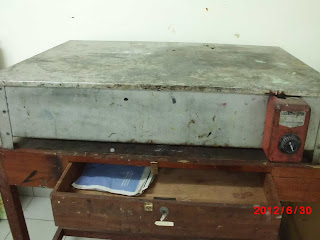AUG 30...
"Confirm received 8 applications and the article. Thanks a lot!
We’ll have a welcome dinner on 16 Nov evening, and the opening ceremony schedule at 17:00 on 17Nov."
... from the Printmaking Triennial organisers
And so... the excitement begins.
To date, most of the 8 Malaysian artists have booked their flights with a return flight from Shenzhen, our stopover after Macau. They will be visiting the Guanlan Printmaking Centre at Shenzhen.
Check some of the blogs on this centre :
China's Printmaking City of Guanlan
The blogger comments : Never one to be outdone in anything, China decided to set up an artists' colony for printmakers. In specific, the Guanlan Centre.... The wonderful thing about
this place is that it’s not just a building or two that is called an
artist colony. The Center makes up a whole village! Guanlan is a 300
year old (ancient by western standards) Hakka fishing village, and in
2008, it was converted into a studio center for printmakers! How
Excellent!
...Unlike the surrounding cities,
the Guanlan Original Print Base is in a peaceful ecological zone. From
the studios the artists overlook vegetable - and strawberry fields. While they harvest one field, they plant new seedlings on the next. From morning to
evening they work in the fields, watering the
plants with two cans at the same time, which are hanging from a bamboo
stick over both shoulders. The fields are surrounded by brooks and ponds
with frogs and ducks, bridges and footpaths. The artists live in 300
years old Hakka village houses. They are built from stone. Wooden galleries and heavy doors are carefully restored. There are watch towers and decorated pe diments mirror in the diverse lakes.
diments mirror in the diverse lakes.
The print base began with it’s
residency program in May 2009. Before they
had already held two biennuals and art fairs. They will build a printing
museum in the next three years.
 diments mirror in the diverse lakes.
diments mirror in the diverse lakes. Shenzhen Guanlan Print Original Base
The entrance of Print Artist
Village at Shenzhen Guanlan Print Original Industry Base on November 21,
2008. [Photo: CRIENGLISH.com/ Xu Liuliu]
Located northeast of Guanlan Town in Shenzhen, the
Guanlan Print Original Industry Base is the spiritual home of Chen
Yanqiao, a pioneer in contemporary Chinese printmaking. The Print Base
is jointly set up by the Shenzhen Bao'an District People's Government,
the China Artists Association and the Shenzhen Federation of Literary
and Art Circles. It includes printmaking works, exhibitions, background
information and research on the fine art. The three parties offer a
platform for academic and commercial development by working on five
projects including the Guanlan International Print Biennial, a Print
Workshop, and the Original Print Fair. The Print Base also provides
ecological and artistic inspiration for visitors who come to appreciate
the works of the famous artists, the ancient Hakka houses and unique
local customs.Printmaking residency in Guanlan
A Guest Post by Evan Summer
In May and June 2010 I was an Artist in Residence at the Guanlan Print Original Industry Base in Guanlan, China. After participating in the 2007 and 2009 Guanlan Biennial Print Exhibitions, they invited me to be an artist in residence. I’ve never traveled much but knew I’d regret it if I didn’t take advantage of this opportunity.
The residencies are usually between three weeks and three months. During that time artists are expected to produce prints in any of the four standard areas: etching, serigraphy, lithography and relief. They are provided with studios, basic supplies, 24/7 access to the workshop and the help of technicians.
*********************************************************************************
NOTE : I originally wanted to post about Macau... but after learning about Guanlan... you can see (from links above) why I'm now sooo eager to visit this place!!





























